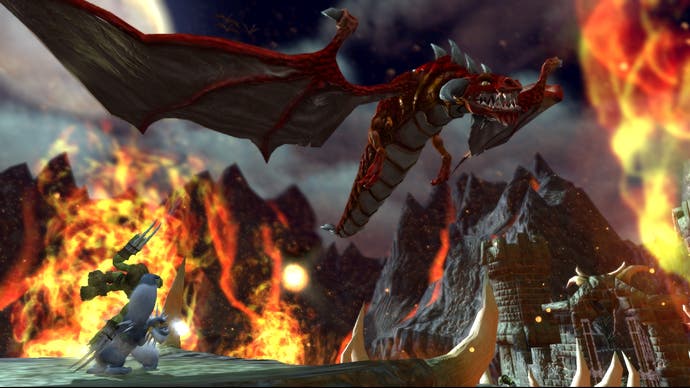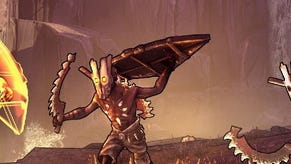Kameo: Elements of Power
Elementary.
Of all the games that make up the Xbox 360's launch line-up, Kameo held the most of this reviewer's confidence. The eloquence of its core transfiguration concept bore the hallmarks of Zelda-envy - hardly a bad thing - while its prolonged development gave rise to sights and sounds more spectacular and silken than many of its launch rivals. All it needed was a world worth exploring, and the sense to let you explore it.
Sultry hip-wiggling and dragonfly wings aside, Kameo's a pretty helpless elf, but with her transformation power she can adopt far more useful forms. The game starts off giving you a decent taste of these - a Sonic spinball for jumping between gaps and half-pipes, a Queensbury boxing plant to bash trolls, and a spiky gorilla for climbing walls and hurling enemies out of windows. Kameo's on a mission to save her family from her evil sister Kalus, who is in league with the nasty troll-king Thorn, so she's busy scaling a gloomy castle circled by cartoon dragons, and this environment is tailored to press each of her transformations' skills into service, at first individually and later in concert. But in the castle's highest tower, Kameo is set upon by Thorn, and her abilities cut away by his killer blow. When she wakes, she's back in her floating village home and unable to do much beyond wiggling around and admiring the swaying grass and wafting blossom.
To regain her initial abilities - and seven others - Kameo must gather the elemental sprites, each of which is held by a nasty shadow demon. These spindly black horrors are spread unevenly among the thematically diverse corners of the scarred game world below her kingdom-home, and to get to them she must solve basic puzzles in each, do battle with trolls, and then open gateways to the shadow realm, where she has to dispatch the increasingly evil identikit demon mini-bosses by drawing spiritual power from their minions and then lobbing it back in their faces the tried-and-trusted three or four times over. Along the way, she also has to save her kidnapped family from giant boss monsters, each of which demands a different mixture of transformations to overcome.

Kameo and her elemental forms are accessed through the face buttons. When you gain more than three forms, you can bind them from within the "Wotnot" book, a predictably sacred tome housing a gobby wizard who dispenses tips and allows you to purchase ability upgrades with elemental fruit pilfered from hapless villagers. Basic movement remains with the left analogue stick more or less for all, and the camera is controlled with the right. Your various abilities - attacking and otherwise - are wielded with the analogue triggers.
The idea, obviously, is that as you gain each elemental form you can apply their skills to overcome environmental obstacles and new enemies on the way to shadowy showdowns and boss-biffing. And so for the most part the game is set up - you gain dragon form in time to open doors by lighting multiple torches, water form in time to operate water wheels and give pummel-able tangibility to ghostly bad guys lurking in huts, and so on. As it wears on, areas regularly demand a combination of abilities. Initially you'll use your spinball to dash off a ledge, then switch to the wall-climbing gorilla in mid-air to continue your castle ascent. A boss encounter further on has you adopting the plant persona to burrow under spiked shells and then flick them in its face, before chucking boulders in its mouth as a pile of rubble, all the while you dodge trolls scattered around the area. Later still, you'll use your flex form to whip the shield out of an enemy's hands, then another to actually duff him up.
However your attacks and any elemental combinations are rarely things you uncover yourself; if you're not told exactly what to do then you can figure it out within seconds. Cannonballs lying around and ramps angled toward catapults? Spinball snooker. Repeat three times. Elsewhere, applying these skills is variously prosaic, awkward or laborious, and always repetitive. Trolls hiding behind shields? Scatter your rubble form's boulders so that they club the trolls from behind as they return to you, then switch to the boxing plant to take care of them as they stand there stunned. Repeat many times over. Once you've established the obvious action, you'll often waste time actually getting the game to let you do it, too - by directing your spin-roll or flame-spitting slightly off-centre, you simply miss and have to do it again. The initial moment of realisation is occasionally beguiling, but any enthusiasm is soon shattered through failure and forced repetition.
The initial process of learning these abilities can be fraught with frustration too - particularly during the opening level. Unpractised hands trying to grasp the three skill-sets one after the other will send Kameo hurtling off ledges and die in combat. This is further hindered by a fitful third-person camera that often spins 180 degrees to face away from enemies when Kameo's struck, so the key skill becomes turning the camera back around while retreating, and this crops up again and again. It's fine if you're used to this sort of fundamental problem, and ultimately ignorable or only intermittently frustrating, but a worryingly basic flaw - and despite running across my front room while turning 180 degrees, several times, I can think of no appropriate analogy for its silliness.

The game hardly ever stops telling you what to do. You're always being asked to grasp new things and their individual quirks, and this abundance of in-game practice sessions and the way they're framed breeds apathy - right from the start of the game-proper, when you're given a basic movement and attack tutorial after the prologue level, and the wizard-in-the-book is so impressed by your ability to look at four torches in turn that he agrees to accompany you on your quest.
At times you feel like the subject of some grand Pavlovian experiment as the cut-away camera gestures to one thing and then another. "Submarines abound," the camera signals, before casually flicking its view to an underwater door. I... must... torpedo the subs to open the underwater door! (Fire, go in, do something, come out.) "Hello little one," the camera greets you. "Here we have boats," it continues, like a girl modelling prizes on a '60s gameshow, "and here is an underwater door." (Fire, go in, do something, come out.) "Now we have subs, and boats," it smiles, "and here an underwacluck-click-cluck-click-click!" This, as you might have guessed, is the sound the analogue stick made as I hit it with my clenched fist. I was desperate to be put in a room with little guidance and forced to experiment.
And yet the game seems loath to do this. I've mentioned the flex form already, right? When you gain him, you realise you can reach platforms with particular plants on them by latching onto their tongues when they open their mouths. It allows you to bridge great distances. But soon you realise that this is basically just a glorified long-jump, and because the game isn't set up to let you tread your own path, you simply do this for a section, and then you barely touch on it again for the rest of the game.
Kameo rarely dies outright or has to repeat much lost progress, but that doesn't lessen the sense of repetition borne of the again-and-again level design. You get bored of it, and her various forms are often individually hamstrung too. Your water form, for example, switches the camera from the right to the left analogue stick whenever you dive in, and has you hold the left trigger to move forward. Why this sudden change? And why can't you move backwards underwater? This issue's particularly acute when you first dive in and the camera lingers above the water so you can't see what's happening for a few seconds. The elements seldom unite to entertain. You kill one boss by fighting the controls and camera to torpedo it underwater, but only after you've gone through the oft-irritating process of trying to snooker bombs off ramps while dodging lightning. The final phase of another boss left me switching between forms in despair until I realised that you could only use the winning strategy in certain areas of the arena.

Combat is a relative pleasure, but it's a sideshow. You can get through the whole game using a basic range of attacks, ignoring most of the upgrades - the spirit bar extensions, which allow you to use puzzle and clearing attacks for longer, are by far the most important. The final boss is the only thing that really demands any advanced combat skill, and that's poor design. What's more, many fights are rendered tedious as you struggle to apply the right technique. Ripping shields from enemies, flipping trolls under spiked shells, hitting giant trolls with glass jaws then using a spike-javelin on their exposed chin within a tiny window of opportunity - figuring them out should be fun, but you're told what to do, applying what you've learned should be fun, but you're constrained by control and camera design.
The way the Xbox 360's graphical power is put to use belies the game's origins on older consoles, too. The level of detail is certainly unprecedented in a console game - scenery is bright and detailed as far as the eye can see, enemies won't shed their features even at a distance or in huge numbers, and the fringes of the game world are carved and polished with every manner of graphical tool and filter imaginable. You're in no doubt that this is a new level of console visuals.
But the environments themselves are stuck in the past. When faced with a gate constructed of metal bars that at least two of your forms are clearly thin enough to slip between, you still have to apply a two-character process to reach the other side - first pound the ground, then burrow beneath the resulting gap. You do this, of course, several times in a row. Other times the game's graphical might serves more to confuse than enlighten, or simply applies its range in tired fashion. There's enough artistic and technical skill here to have you seek out unique landmarks that mark the path onward, but instead you look for the glowing doorway in amongst the samey objects, individually detailed and beautifully texture-mapped though they are.
The underlying concept of combining the abilities of multiple characters is unquestionably a good one, and sometimes it works quite well but its application is mostly forced and repetitive, and it doesn't let you off the leash until it's almost over. The game is well organised, but only by virtue of leaving you in little doubt of where to go and what to do when you get there, and then asking you to do it several times in a row. All too infrequently do you discover anything for yourself and there's rarely a puzzle that demands more than a few seconds' thought or observation. If you need to pummel four totems in a particular order, and you know which comes first, it doesn't take long to spot that each has a certain number of ram's-skulls-on-sticks next to it. One, two, three, and, by Jove, four.

The detail around the edges fleshes out the world, but only with mediocrity. A thousand units fight for control of the Badlands area at the centre of the game world, and you can join in the fight or simply wade through the carnage on horseback, but it's just a pretty backdrop that you can only influence when you're told to get involved, and for no reward - on one occasion this happens just as you're in the middle of doing something with a tangible prize at the end of it. Elsewhere, villagers all have something to say, but never anything that interesting. Some ask you to clear their huts of enemies, but you only do this because you want their elemental fruit. In fact, everybody talks too much - and you'll regularly find yourself flicking past the voice acting during key moments of exposition. There's very little joy in any of it.
Expectations are often too high with console launch titles, or people simply don't know what to expect. Kameo makes it simple. Rare said that the game was basically completed on past systems anyway, then touched up, and that's incredibly obvious. Its development on Xbox 360 has borne graphical polish that couldn't be achieved on anything but today's highest-end PCs, but the core game is nothing you'll have trouble referencing. Enemies do what game enemies have always done, puzzles are solved the way they always have been, and events unfold predictably - both in content and sequence, which almost never leaves exploration up to you - and repetitively, as most areas are shaped to open their doors in accordance with your most recent acquisitions. And then open the next ones the same way two minutes later.
The world of Kameo certainly asks of the console hardware what past games could not, but it doesn't ask any new questions of the player. Instead of flowering, petal by distinctive petal, it just showers you with new seeds as you toil to bed the old ones, and then tells you to sow and sow and so on until you're bored. The result is a game that struggles to entertain, and one that I was quite finished with by the end.








